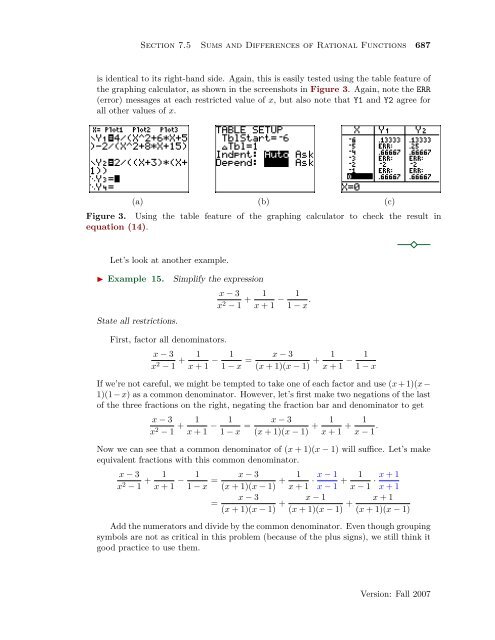Chapter 7 Rational Functions - College of the Redwoods
Chapter 7 Rational Functions - College of the Redwoods
Chapter 7 Rational Functions - College of the Redwoods
Create successful ePaper yourself
Turn your PDF publications into a flip-book with our unique Google optimized e-Paper software.
Section 7.5 Sums and Differences <strong>of</strong> <strong>Rational</strong> <strong>Functions</strong> 687<br />
is identical to its right-hand side. Again, this is easily tested using <strong>the</strong> table feature <strong>of</strong><br />
<strong>the</strong> graphing calculator, as shown in <strong>the</strong> screenshots in Figure 3. Again, note <strong>the</strong> ERR<br />
(error) messages at each restricted value <strong>of</strong> x, but also note that Y1 and Y2 agree for<br />
all o<strong>the</strong>r values <strong>of</strong> x.<br />
(a) (b) (c)<br />
Figure 3. Using <strong>the</strong> table feature <strong>of</strong> <strong>the</strong> graphing calculator to check <strong>the</strong> result in<br />
equation (14).<br />
Let’s look at ano<strong>the</strong>r example.<br />
◮ Example 15.<br />
State all restrictions.<br />
Simplify <strong>the</strong> expression<br />
First, factor all denominators.<br />
x − 3<br />
x 2 − 1 + 1<br />
x + 1 − 1<br />
1 − x .<br />
x − 3<br />
x 2 − 1 + 1<br />
x + 1 − 1<br />
1 − x = x − 3<br />
(x + 1)(x − 1) + 1<br />
x + 1 − 1<br />
1 − x<br />
If we’re not careful, we might be tempted to take one <strong>of</strong> each factor and use (x + 1)(x −<br />
1)(1 − x) as a common denominator. However, let’s first make two negations <strong>of</strong> <strong>the</strong> last<br />
<strong>of</strong> <strong>the</strong> three fractions on <strong>the</strong> right, negating <strong>the</strong> fraction bar and denominator to get<br />
x − 3<br />
x 2 − 1 + 1<br />
x + 1 − 1<br />
1 − x = x − 3<br />
(x + 1)(x − 1) + 1<br />
x + 1 + 1<br />
x − 1 .<br />
Now we can see that a common denominator <strong>of</strong> (x + 1)(x − 1) will suffice. Let’s make<br />
equivalent fractions with this common denominator.<br />
x − 3<br />
x 2 − 1 + 1<br />
x + 1 − 1<br />
1 − x = x − 3<br />
(x + 1)(x − 1) + 1<br />
x + 1 · x − 1<br />
x − 1 + 1<br />
x − 1 · x + 1<br />
x + 1<br />
x − 3<br />
=<br />
(x + 1)(x − 1) + x − 1<br />
(x + 1)(x − 1) + x + 1<br />
(x + 1)(x − 1)<br />
Add <strong>the</strong> numerators and divide by <strong>the</strong> common denominator. Even though grouping<br />
symbols are not as critical in this problem (because <strong>of</strong> <strong>the</strong> plus signs), we still think it<br />
good practice to use <strong>the</strong>m.<br />
Version: Fall 2007

















